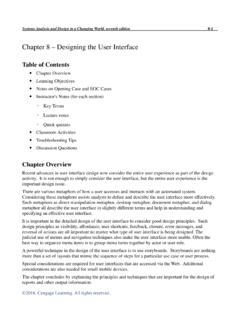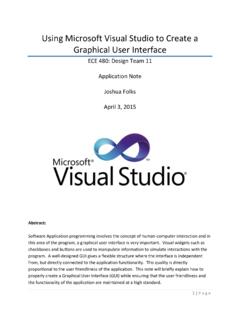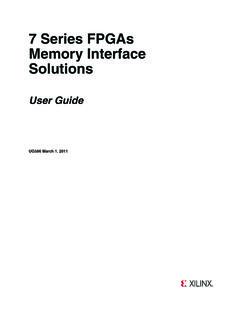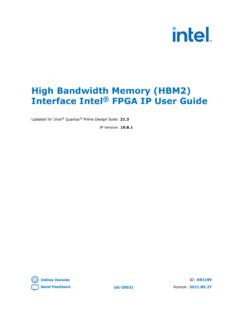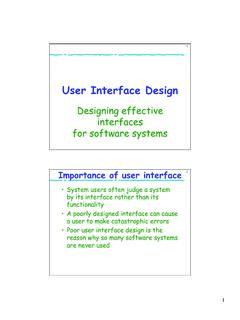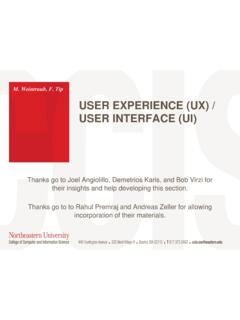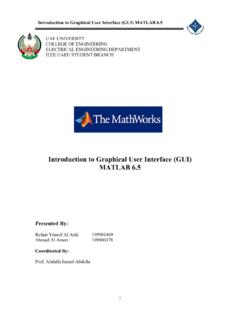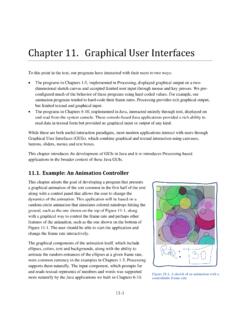Transcription of ATM User Interface Design - Vassar College
1 ATM user Interface DesignRequirements A bank customer is able to access his or her account using an automatic teller machine. To be able to use an ATM a customer must first register an account number and a passcode number. The customer s information is then added to a list of registered users. The ATM user Interface consists of a keypad, a display window, a selection of choice options, and a help screen that displays instructions for completing an ATM transaction. Users are asked to enter their account number from the keypad followed by their passcode. If the customer is a valid user , instructions are given for choosing a transaction.
2 During a transaction, the user s account is accessed and updated. Upon completion of a transaction, the user may elect to make another transaction or to statement of requirements for a portion of the system may be extracted from the use cases and other Inception documents. A brief narrative is useful for identifying the problem domain objects (concepts).This prototype simulates the actual machine that includes a card reader and buttons implemented in the bank customeris able to accesshis or her accountusing an automatic teller machine. To be able to use an ATMa customermustfirst registeran account numberand apasscode number.
3 The customer s informationisthen added toa list of registered users. The ATM user interfaceconsists ofa keypad, a display window, a selection of choice options, and a help screenthat displaysinstructions for completing an ATM transaction. Usersareasked to entertheir account numberfrom the keypadfollowed by theirpasscode. If the customerisa valid user , instructionsare givenfor choosing a transaction. During a transaction, the user s accountis accessedand updated. Upon completion of a transaction, the usermay elect to makeanother transactionor to the noun phrases and verb phrases in the narrativeList of Noun PhrasesBank customerAccount Automatic teller machineATMA ccount numberPasscode numberCustomer informationList of registered usersATM user interfaceKeypadDisplay windowHelp screenSelection of choice optionsTransaction Concept ConceptRedundant.
4 Same as ATMC oncept Attribute Attribute Concept Concept ConceptBut in this example the ATM relates only to the user Interface same as ATMC onceptConceptConceptConceptConcept Instructions AttributeText stringsAssociationsCustomeraccessesAccou nt (via ATM)Customer Informationis added toList of registered usersATMconsists ofKeypad, Display, Help screen, Selection of choice optionsAccountis accessed by(ATM)ATMverifiesCustomer InformationImplicitCustomer hasAccountKeypad hasButtonsChoice Selection usesButtonsDraw a Domain Model relating these ConceptsState Transition DiagramImplementation of a PrototypeTo provide an illustration of the ATM user Interface , we will implement an Applet that uses stubs to represent the Account, UserList, and CustomerInfo prototype shows a working model of the user Interface with the message sequence that the customer will encounter.
5 The purpose of the prototype is to examine the human factors issues relating to the Interface and to make certain that there are no deadlocks or partial cycles and that each transaction will properly terminate and return the system to the welcome ATM user InterfaceTest Plan for the user Interface PrototypeTest Plan for the Interface the paths through the system to be testedWelcome screen (ask for Account Number) (DIGITS + ENTER) Passcode State (Ask for Passcode) (DIGITS + ENTER) Select State (Show Options) (DEPOSIT or WITDRAW + ENTER) Deposit State or Withdraw State (Key-in amount and press ENTER) Other State (Ask if user wants to make another transaction) (CLEAR = NO) Goodbye screen (if answer is NO) (CLEAR) Welcome screen is returnedAlternative paths from Select StateUser aborts transaction by pressing CLEAR Goodbye (CLEAR) WelcomeUser selects check balance (BALANCE) Other State (CLEAR = NO) Goodbye screen (CLEAR) WelcomeTest Plan for user Interface PrototypeOther Alternate PathsAfter a Deposit or Withdrawl make another transactionDeposit (ENTER) Other State(ENTER = YES)
6 Select screen (BALANCE) Other State (CLEAR = NO) Goodbye screen (CLEAR) WelcomeTest that pressing ENTER before keying in the amount of the deposit or withdrawl will generate the appropriate error message recovery debugging and testing the prototype, keep a log of corrections and changes made in the should NOT record simple errors like missing semicolons, missing parentheses, or misspelled identifiers, but errors that lead to changes in the code like adding the boolean hold flag to ensure that the goodbye screen would display after a balance to the code made during debugging and testing can modify or override Design decisions and should be documented for later of TestingErrors Detected Account numbers and passcodes that are 9 digits or longer can cause integer overflow errors.
7 If ENTER is pressed before an amount is indicated when performing a withdrawal, then ENTER must be pressed twice after an amount has been entered before the correct screen is for the Next IterationStart Date: Sept. 9, 2004 Due Date: Sept. 23, 2004 ArtifactCommentUse cases:WithdrawalDepositCheck BalanceUse cases describe the main sequence scenario and lists alternate sequence scenarios (to be developed in next iteration). Fully dressed use cases are begun for each of these case diagramsFrom the Actor-Goal List, identify use cases and the actors that participate in each.
8 Display the system ListIdentify the stakeholders (and external systems) and make a list of the goals that each might have. State Model DiagramAdd error states for incorrect passcode do not accept passcodes with more than 6 a table for verifying user accounts/passcode. Construct a database for user accounts and incorporate these data bases into the ATM the artifacts listed in the iteration Plan. In use cases for Witrhdraw, Deposit, and Check Balance (as described in the comments.) an Actor-Goal List and Use Case a Table for verifying account number/passcode pair.
9 Assume that Account numbers are pre-assignned and let the passcodes be established at that time. (You may add the ability for a user to change his/her passcode as an option in this a database for user accounts. (A structure of your own creation holding account information and providing methods for performing transactions will suffice here.) the databases into the prototype system. Add checking of account number/passcode for valid user (and don t allow passcode numbers greater than 6 digits). a test plan for testing the prototype and perform test.)
